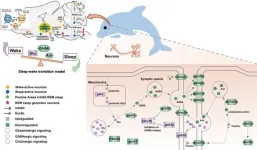(Press-News.org)
A new study led by the Barcelona Institute for Global Health (ISGlobal), a centre supported by the "la Caixa" Foundation, has found that children exposed to higher levels of air pollution in early and mid childhood have weaker connections between key brain regions. The findings, published in Environment International, highlight the potential impact of early exposure to air pollution on brain development.
The research showed reduced functional connectivity within and between certain cortical and subcortical brain networks. These networks are systems of interconnected brain structures that work together to perform different cognitive functions, such as thinking, perceiving and controlling movement. These findings are consistent with previous studies suggesting that air pollution may be associated with changes in the functional connectivity of brain networks, particularly in children. However, it is not yet fully understood how air pollution affects the development and maturation of these brain networks.
The study analysed data from 3,626 children from the Generation R cohort in Rotterdam, the Netherlands. Exposure to air pollution at the participants' residence, including particulate matter (PM2.5 and PM10), nitrogen dioxide (NO2) and nitrogen oxides (NOX), was estimated using statistical models that combine actual measurements with environmental characteristics. Brain connectivity was then assessed both between and within networks, including 13 cortical networks and three subcortical regions: the amygdala - responsible for processing emotions and triggering survival responses -, the hippocampus - key for memory formation and spatial orientation -, and the caudate nucleus - involved in movement regulation, memory and decision-making.
The children were evaluated using resting state neuroimaging, meaning their brains were scanned while not performing any active task, at two time points: around the age of 10 and again at an average age of 14. Exposure to air pollution was analysed over two periods: from birth to three years of age and in the year before the neuroimaging assessment.
“This is one of the first studies to explore how air pollution affects brain connections at rest, using brain scans taken multiple times in a large group of children from birth,” says Michelle Kusters, ISGlobal researcher and first author of the study.
Persistent Associations During Adolescence
The results show that greater exposure to air pollution from birth to three years old is associated with lower connectivity between the amygdala and the cortical networks involved in attention, somatomotor function - which coordinates body movements - and auditory function. Additionally, higher exposure to PM10 particles in the year before the neuroimaging assessment was associated with lower functional connectivity between the salience and medial-parietal networks, which are responsible for detecting stimuli in the environment and for introspection and self-perception.
“These associations persist throughout adolescence, which may indicate persistent disruptions in the normal development of brain networks due to pollution exposure. This could affect emotional processing and cognitive functions,” explains Mònica Guxens, ICREA researcher at ISGlobal and lead author of the study. “However, more research is needed to confirm these findings and to understand their exact impact on brain development,” she adds.
Changes in Brain Volume
Another recent study by the same team examined the relationship between exposure to air pollution during pregnancy and childhood, and changes in brain volume through adolescence. The study was based on data from 4,243 children from the same Generation R cohort, who underwent repeated assessments of white matter, cortical grey matter, the cerebellum, and seven subcortical volumes.
The results revealed that exposure to air pollution during pregnancy, particularly to fine particles (PM2.5) and copper, was associated with a smaller volume of the hippocampus, a crucial brain structure for memory function, at age 8. However, as the children grew, "compensatory growth" in the hippocampus was observed, suggesting that brain plasticity, particularly in this area, may counteract some of the initial negative effects of pollution exposure. Despite the early effects on hippocampal volume, no significant associations were found between air pollution and other brain volumes, such as white matter, cortical grey matter, or the cerebellum.
Importance of Policy Changes
According to the research team, these findings together underscore the potential long-term impact of early-life air pollution exposure on brain connectivity and development. “While some brain regions may exhibit compensatory growth, the persistent disruptions observed in functional networks highlight the need for further research into the mechanisms behind these changes. Given the widespread exposure to air pollution, these results reinforce the importance of policies aimed at reducing pollution levels, particularly in urban environments, to safeguard children's brain development," says Michelle Kusters.
References
Kusters, MSW., Granés, L., Petricola, S., Tiemeier, H., Muetzel, RL., Guxens, M. Exposure to residential air pollution and the development of functional connectivity of brain networks throughout adolescence. Environment International, Volume 196, February 2025. Doi: 10.1016/j.envint.2024.109245
Kusters, MSW., Binter, AC., Muetzel RL., López-Vicente, M., Petricola, S., Tiemeier, H., Guxens, M. Outdoor Residential Air Pollution Exposure and the Development of Brain Volumes Across Childhood: A Longitudinal Study. Environment Pollution, March 2025. Doi: 10.1016/j.envpol.2025.126078
END
LOS ANGELES — Researchers with City of Hope, one of the largest and most advanced cancer research and treatment organizations in the United States, with its National Medical Center in Los Angeles ranked among the nation’s top 5 cancer centers by U.S. News & World Report, and MSK have created a tool that uses machine learning to assess a non-Hodgkin lymphoma (NHL) patient’s likely response to chimeric antigen receptor (CAR) T cell therapy before starting the treatment, according to study results published today in Nature Medicine.
CAR T cell therapy ...
New projections by the UNSW Institute for Climate Risk & Response (ICRR) reveal a 4°C rise in global temperatures would cut world GDP by around 40% by 2100 – a stark increase from previous estimates of around 11%.
The recently-published analysis fixes an oversight in the current economic model underpinning global climate policy, toppling previous carbon benchmarks.
The results support limiting global warming to 1.7 °C, which is in line with significantly faster decarbonisation goals like the Paris Agreement, and far lower than the 2.7°C supported ...
While the Middle Paleolithic period is viewed as a dynamic time in European and African history, it is commonly considered a static period in East Asia. New research from the University of Washington challenges that perception.
Researchers discovered a complete Quina technological system — a method for making a set of tools — in the Longtan site in southwest China, which has been dated to about 50,000 to 60,000 years ago. Quina technology was found in Europe decades ago but has never before been found in East Asia.
The team published its findings March ...
Whales and dolphins sleep by turning off one half of their brains at a time; scientists discover more about the genes and pathways that enable this phenomenon.
####
Article URL: https://plos.io/4c9g5gm
Article Title: Evolution of canonical circadian clock genes underlies unique sleep strategies of marine mammals for secondary aquatic adaptation
Author Countries: China
Funding: This work was supported by the National Key Research and Development (R&D) Program of China (grant no. 2022YFF1301600) to G.Y. & S.X., the Key Project ...
Life emerged on Earth some 3.8 billion years ago. The “primordial soup theory” proposes that chemicals floating in pools of water, in the presence of sunlight and electrical discharge, spontaneously formed organic molecules. These building blocks of life underwent chemical reactions, likely driven by RNA, eventually leading to the formation of single cells.
But what sparked single cells to assemble into more complex, multicellular life forms?
Nature Physics published a new insight about a possible driver of this key step in evolution — the fluid ...
ALL ALS Consortium Launches Website to Advance ALS Research
The Access for All in ALS (ALL ALS) Consortium announced the launch of its official website, creating a central hub for information about its initiatives and clinical research studies. ALL-ALS.org is designed to inform and engage researchers, clinicians, and current and prospective study participants.
The ALL ALS Consortium formed in fall 2023 with funding from the National Institutes of Health (NIH). The consortium consists of 35 clinical sites in the United States and Puerto Rico, led by researchers at Barrow Neurological Institute in Phoenix, Arizona and Massachusetts ...
EMBARGOED UNTIL 6:30 P.M. EST on Monday, March 31, 2025
Contact:
Jillian McKoy, jpmckoy@bu.edu
Michael Saunders, msaunder@bu.edu
##
Many TB Cases May Have Gone Undetected in Prisons in Europe and the Americas During COVID-19
A new study found that reported diagnoses for tuberculosis were consistently lower than expected throughout the pandemic, even though incarceration rates remained largely consistent and TB detection among the general population managed to reverse after an early-pandemic decline.
Incarcerated populations have a high risk of developing tuberculosis ...
UNDER EMBARGO UNTIL 00.01 AM BST ON TUESDAY 1 APRIL
The new Electronic Frailty Index 2 (eFI2) is now available to 60% of England’s GPs thanks to research funded by the National Institute of Health and Care Research (NIHR) and conducted by researchers at the University of Leeds and UCL
GP data on 36 health problems such as dementia, falls and fractures will help medical professionals to more accurately identify older people’s frailty and intervene earlier
Interventions may include a holistic assessment and treatment plan, falls prevention, targeted medicines review, and resistance exercise ...
A study from the University of Ottawa’s Human and Environmental Physiology Research Unit (HEPRU) has confirmed that the limits for human thermoregulation—our ability to maintain a stable body temperature in extreme heat—are lower than previously thought.
This research, led by Dr. Robert D. Meade, former Senior Postdoctoral Fellow and Dr. Glen Kenny, Director of HEPRU and professor of physiology at uOttawa's Faculty of Health Sciences, highlights the urgent need to address the impacts of climate change on human health.
The study found that many regions may soon experience heat and humidity levels that exceed the safe limits ...
Texas has the most rural residents of any state, with nearly 3 million people spread across a vast landscape. If rural Texas were its own state, it would rank as the 36th most populous.
Yet, rural Texans face significant barriers to health care that their urban counterparts do not. More than a quarter of the state’s 172 rural counties lack a hospital, and those with at least one hospital often struggle with a shortage of qualified health care personnel, such as nurses and first responders.
To address these growing challenges, The University of Texas at Arlington introduced its new Mobile Simulation Lab on Friday. It’s the first in Texas dedicated ...



